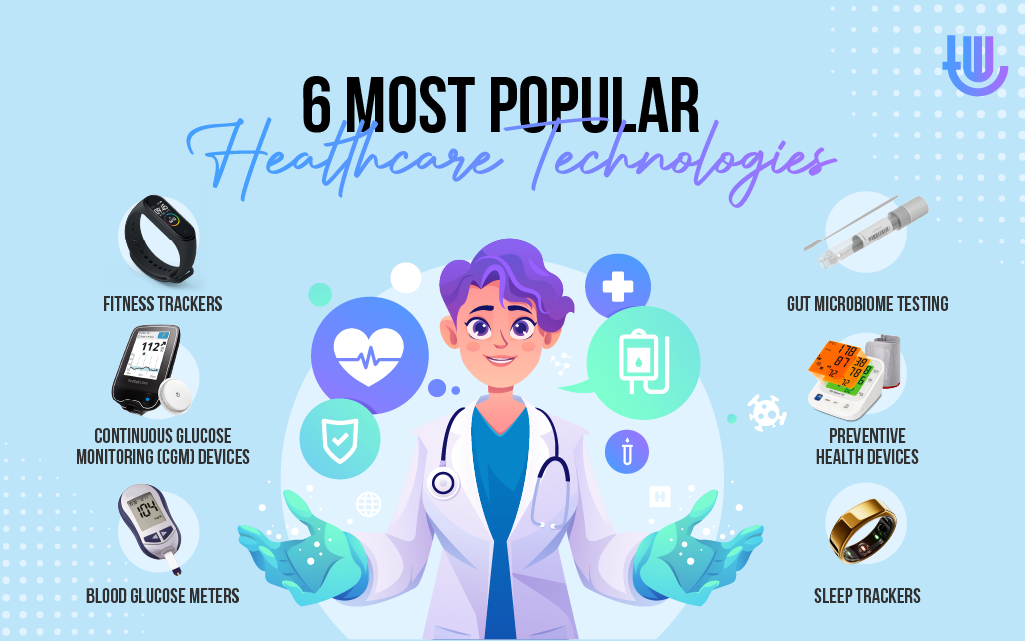Constant improvements in technology have paved the way for many innovative ideas and inventions, especially in the healthcare sector. The combination of health and tech has led to the introduction of various medical technologies such as continuous blood sugar monitoring and gut microbiome testing which have shown to be very effective in testing and tracking patient health.
Some healthcare technologies that continue to gain increasing popularity in late 2022 include:

Fitness Trackers
These are devices that look like digital watches and are most commonly worn on the wrist. Fitness trackers record various stats such as how many steps you’ve taken during the day and your heart rate during physical activity. These stats are typically recorded by the most basic fitness trackers but the more expensive, higher-end devices can also track how many calories you’ve burned during your workouts as well as your sleeping patterns. With fitness trackers, you can even sync them to the app and set personalized goals for yourself such as the number of steps you would like to achieve per day and how long you would like your workouts to last.
Continuous Glucose Monitoring (CGM)
Like fitness trackers, CGM devices are also wearable and help in regularly tracking blood glucose levels which is especially essential for diabetic patients. In order for this to work, a sensor is usually placed under your skin, and measures of your blood sugar levels are regularly taken and sent to another device for perusal. CGM data is downloadable and can be used by your healthcare provider for in-depth analysis to aid in the personalization of your treatments.
Blood Glucose Meters (Glucometers)
Compared to continuous glucose monitoring, glucometers do not regularly take readings of blood sugar levels and work by introducing a tiny sample of blood into the glucometer via a test strip. You will then have to wait for a few seconds before your results appear after which you can note them down for your records or for perusal by your healthcare provider. As mentioned, these readings are not spontaneous so glucometers do not offer the same convenience that CGM provides but are effective nonetheless.
Gut Microbiome Testing
Several healthcare providers now have the ability to perform analysis of the bacteria in your gut through microbiome testing. It involves the collection of a stool specimen which will then be analyzed in a lab to check for certain types of bacteria such as those that cause disease and how many of these are present. These results give an indication of an individual’s gut health which can be used by the provider to recommend solutions that would help encourage the growth of beneficial gut bacteria to improve overall body health.
Preventive Health Devices
Surely you must have heard of the saying “prevention is better than cure”; this is especially true for those conditions which cannot be completely cured but only managed with long-term maintenance medicine. This saying also forms the basis of the design of preventive health devices which aim to prevent the onset of disease. An at-home health test kit is one such preventive health invention that involves the collection of a saliva or blood sample to be analyzed for the presence of certain health conditions so that measures can be taken early on to suppress them.
Sleep Trackers
These are very similar to fitness trackers in that they are wearable except that they exclusively measure your sleeping patterns. Sleep trackers are capable of recording and measuring the duration and quality of your sleep—how often you keep waking up during the night or toss and turn in bed. Some high-end trackers can also detect the atmosphere in your room while you sleep and prompt you to record certain factors which may affect your sleeping patterns like how much caffeine you’ve had during the day and when you’ve had your meals.
Conclusion
Health and tech continuously go hand-in-hand to give rise to various healthcare technologies that aim to make processes easier for both patients and those who work in the healthcare sector. It goes without saying that the use of tech will without a doubt continue to streamline and revolutionize the healthcare industry for many years to come.